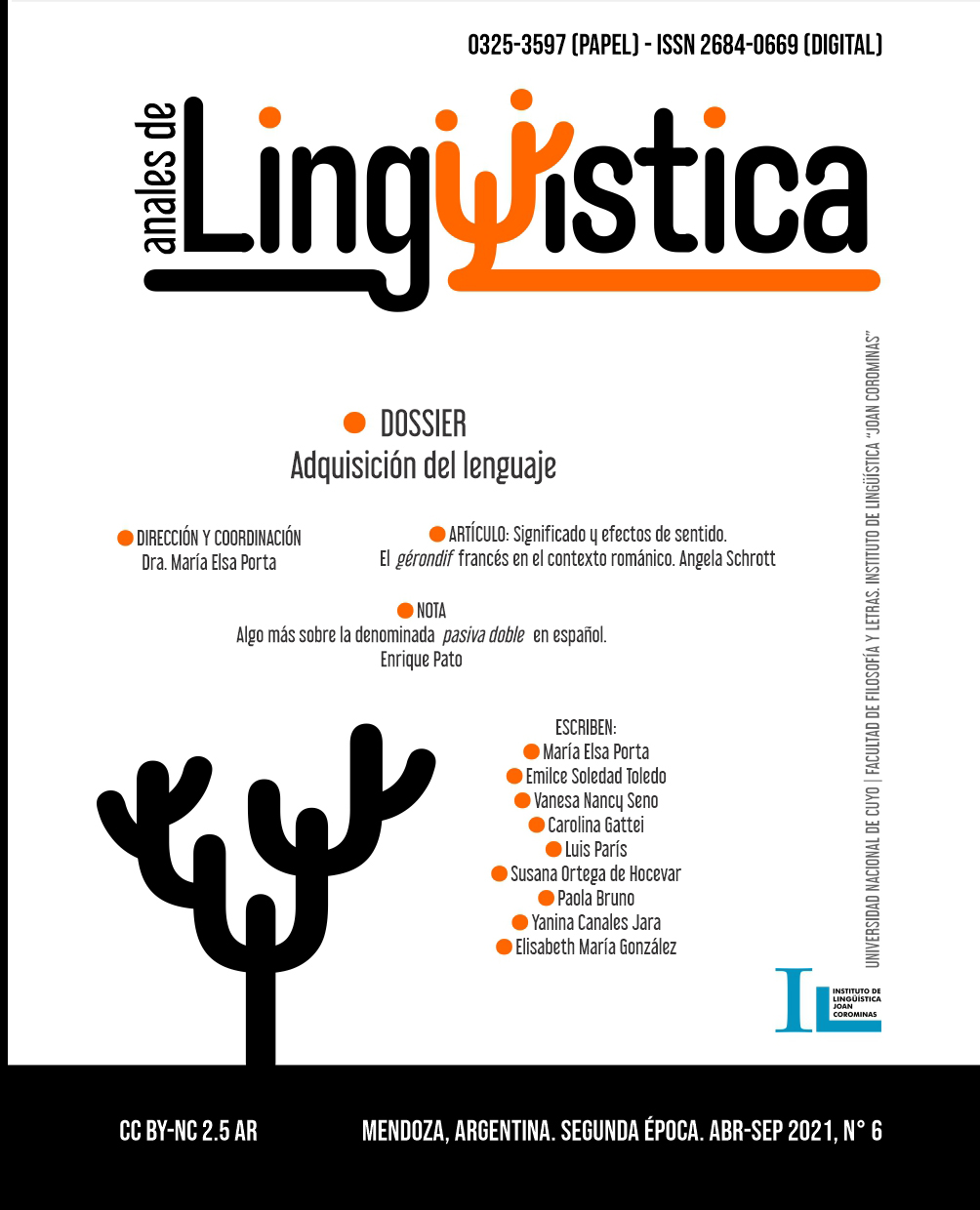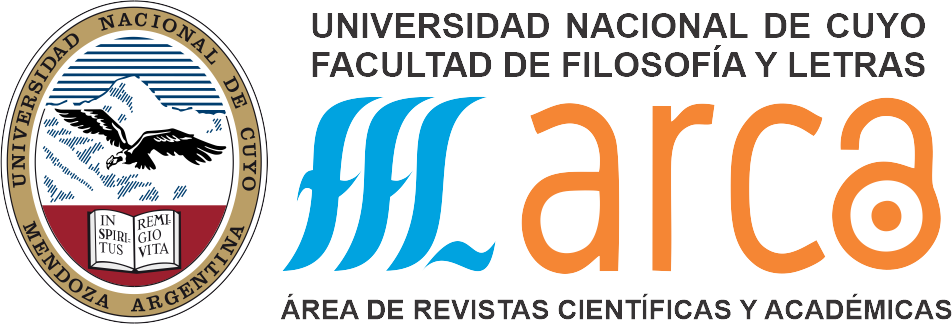Semantic errors in children’s narratives: the problem of reference
Keywords:
semantic slips, oral production, children narrativeAbstract
The aim of this paper is to develop a set of categories able to describe semantic slips of the tongue in oral production of narratives by five years old children.
The analysis is framed within Cognitive Linguistics since it studies the relation between language and cognition in the context of a communicative situation, language in a particular context of use: the narration of a dynamic visual stimuli.
In particular, this study is part of a research program called 'Interface Grammar'. We undertook a qualitative and descriptive analysis. Children were presented twice with two visual stimuli and asked to narrate them. The narratives were transcribed and analyzed. We identified thirteen semantic slips, which were described and classified. First, we contrasted the meaning of the verb used by the child with the segment of the stimuli intended to be referred to by the expression. We identified the information in the stimuli that was not covered by the verb meaning. Then, we justify our interpretation of the use of that expression as a 'failed reference' by the relevance of the omitted information. The result consists of six categories that allow us to start to classify reference problems in children's discourse.
References
Bishop, D. y Adams, C. (1992). Comprehension problems in children with specific language impairment: literal and inferential meaning. Journal of Speech and Hearing Research, (35), 119-129.
Bruner, J. (1986). El habla del niño. Barcelona: Paidós.
Bruner, J. (1990). La educación, puerta de la cultura. Madrid: Visor.
Clark, A. (1989). Más allá del eliminativismo. Mente y lenguaje, (4), 251-279. doi.org/10.1111/j.1468 0017.1989.tb00256.x
Gathercole, S. E. y Baddeley, A. D. (1993). Ensayos en psicología cognitiva. Memoria de trabajo y lenguaje. Hove: Lawrence Erlbaum Associates, Inc.
Gattei, C. A., Wainselboim, A. J., y París, L. (2012). El papel del orden de los argumentos semánticos y la interfaz sintaxis-semántica. En: A. García, V. Orellano y V. Jaichenco. (Eds.). Lenguaje, Cognición y Cerebro (pp. 127–144). Mendoza, Argentina: Editorial FFYL-UNCuyo y SAL
Gattei, C. A., Dickey, M. W., Wainselboim, A. J., and París, L. (2014). The thematic hierarchy in sentence comprehension: A study on the interaction between verb class and word order in Spanish. The Quarterly Journal of Experimental Psychology, 68 (10), 1981–2007.
Glaser, B., y Strauss, A. (1967). The Discovery of Grounded Theory. Chicago: Aldine Publishing Company.
Gorman, B. K., Bingham, G. E., Fiestas, C. E. y Terry, N. P. (2016). Assessing the narrative abilities of Spanish-speaking preschool children: A Spanish adaptation of the narrative assessment protocol. Early Childhood Research Quarterly, 36, 307-317. doi.org/10.1016/j.ecresq.2015.12.025
Hernández Sampieri, R.; Fernández Collado y Lucio C. B. (2014). Metodología de la investigación. (6° Ed.). México D.F.: Mc Graw –Hill Interamericana Editores.
Labov, W. y Waletzky, J. (1967). Narrative analysis: Oral versions of personal experience. En J. Helm (Ed.), Essays on the verbal and visual arts (pp. 12-44). Seattle, WA: University of Washington Press.
László, J. (2008). The science of stories: An introduction to narrative psychology. New York, NY: Routledge.
Nelson, K. (1989). Monologue as representation of real life experience. En K. Nelson (Ed.). Narratives from the crib (pp. 27-32). Cambridge, MA: Harvard University Press.
Nelson, K. (1996). Language in Cognitive Development. Cambridge: Cambridge University Press.
Nelson, K. (2007). Young Minds in Social Worlds. Experience, Meaning and Memory. Cambridge: Harvard University Press.
París, L. (2007). Acciones Verbales en una primera entrevista. Revista Metavoces 3, UNSL. Coautores: E. Car y M. Doffo, (pp. 11-31).
París, L. (2008). On Expanditures. En: N. Adams, A. Cooper, F. Parrill y T. Wier, (eds.). Proceedings of the 40th Regional Meeting of the Chicago Linguistic Society, 291-304. Chicago: CLS.
París, L. (2010). El significado como concepto estructurado. En: G. Müller, V. Barbeito y L. Miñones (Eds.). Estudios de Lingüística Cognitiva (pp. 241-257). Mendoza: EDIUNC.
París, L. (2011). Invisibilidad semántica de lo conceptual. En: V. Jaichenco y Y. Sevilla (Ed.). Primer Encuentro de Procesamiento del Lenguaje (pp. 192-201). Buenos Aires: Editorial de la FFyL, UBA. Recuperado de http://il.institutos.filo.uba.ar/sites/ il.institutos.filo.uba.ar/files/PROLEN%202012.pdf
París, L. & Suárez Cepeda, S. (2013). Experiencia y conceptualización. En: A. Adelstein (Ed.). Interfaces Semánticas, volumen de la Sociedad Argentina de Lingüística. Mendoza: Editorial FFyL, UNCuyo.
Rondal, J. A. (1988). Desarrollo del lenguaje en el síndrome de Down: una perspectiva a lo largo de la vida. Revista internacional de desarrollo conductual, 11 (1), 21-36. doi/10.1177 / 016502548801100103
Stein, N. L. (1982). The definition of a story. Journal of Pragmatics, 6, 487-507.
Strauss, A. L. y Corbin, J. (1990). Basics of Qualitative Research: Grounded Theory, procedures and techniques. Sage Publications Newbery Park, CA.
Suárez Cepeda, S. y París, L. (2014). Estructura temporal de las narrativas de estímulos visuales dinámicos. Aproximaciones teóricas y empíricas a la Lingüística Cognitiva. Mar del Plata: Eudem.
Tessler, M. (1986). Mother-child talk in a museum: The socialization of a memory. Manuscrito no publicado, University of New York Graduate Center.
Tomasello, M. (2008). The origins of communication. Cambridge, MA: MIT Press.
Trevor, H. (2006). Speech Errors: Psycholinguistic Approach. Encyclopedia of Language & Linguistics. doi.org/10.1016/B0-08-044854-2/00797-5.
Vygotski, L. S. (1978). El desarrollo de los procesos psicológicos superiores. México: Grijalbo.
Downloads
Published
How to Cite
Issue
Section
License
Copyright (c) 2021 Anales de Lingüística
Esta obra está bajo una Licencia Creative Commons Atribución 2.5 Argentina.
Los/as autores/as que publican en esta revista están de acuerdo con los siguientes términos:
1. Los/as autores conservan los derechos de autor y garantizan a la revista el derecho de ser la primera publicación del trabajo bajo una licecncia Creative Commons Atribución 2.5 Argentina (CC BY 2.5 AR) . Por esto pueden compartir el trabajo con la referencia explícita de la publicación original en esta revista.
2. Anales de lingüística permite y anima a los autores a difundir la publicación realizada electrónicamente, a través de su enlace y/o de la versión postprint del archivo descargado de forma independiente.
3. Usted es libre de:
Compartir — copiar y redistribuir el material en cualquier medio o formato
Adaptar — remezclar, transformar y construir a partir del material para cualquier propósito, incluso comercialmente.












